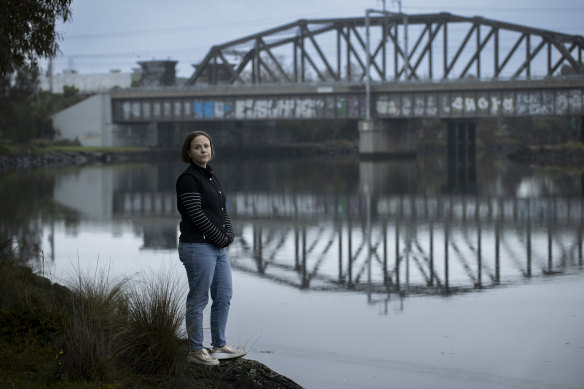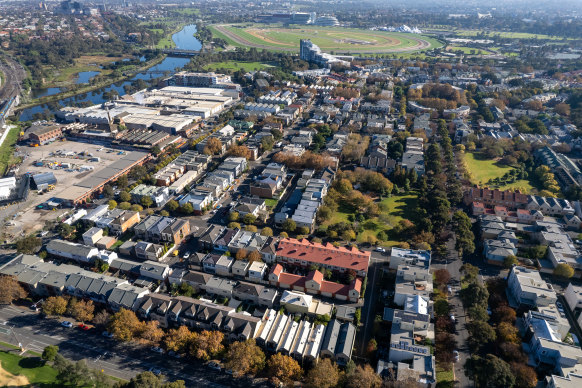- Exclusive
- National
- Victoria
- Victoria floods
This was published 1 year ago
Home owners to pay a combined $1m to find out how much they will be flooded
By Sophie Aubrey and Clay Lucas
More than 1000 Kensington home owners already in financial turmoil after their properties were declared flood-prone now face bills totalling close to $1 million after being told by Melbourne Water to hire their own land surveyors.
Melbourne Water told owners in the inner-city suburb’s Kensington Banks development that it was up to them to make sense of complex new Maribyrnong River modelling data on revised flood levels. The new levels, which replaced outdated 2003 flood maps, were set following 2022’s Maribyrnong flood, which damaged about 600 homes upstream of Kensington.

Donna Thompson is devastated by the new flood mapping over Kensington Banks.Credit: Arsineh Houspian
The water authority says 905 properties in Kensington would be at risk if a major flood happened today. By the end of this century, this would increase to 1034 homes – the scenario that will be used to inform local planning laws, insurance costs and bank loans.
Victorian Greens leader Ellen Sandell, who represents Kensington in the seat of Melbourne and also lives in Kensington Banks, said there were serious questions about the failure to plan the housing development properly. Sandell will next week use parliament to refer the matter to the Victorian ombudsman.
A local land-surveying business told The Age its services would typically cost between $850 and $1200, meaning the total bill for surveying could be about $1 million for the 1034 properties.
“Melbourne Water has put over 900 families in this awful situation, so Melbourne Water should pay these costs,” Sandell said.
She said it was ridiculous to expect families to pay for their own land surveyors to decipher the flood risk to their homes, when they were already dealing with soaring insurance costs and plunging house values.
She wants compensation and fast-tracked flood-prevention works for the area. Last week, she organised a community meeting attended by more than 220 people, most of whom were blindsided by the new flood zoning because no Kensington homes were inundated in 2022.
Sandell said residents had moved into the area with information provided by the government that their homes were above flood levels. “It now seems the state government got this wrong – so why should families with huge mortgages bear the costs for [their] mistakes?” she said.
Since releasing its new flood modelling, Melbourne Water has sent individualised reports to residents, including the level water is expected to reach on their property if a one-in-100-year flood happened.

An aerial view of the Kensington Banks estate, which has been labelled flood-prone in Melbourne Water’s revised modelling.Credit: Jason South
The reports also project what these flood levels will be in the year 2100.
Residents have been alarmed by the reports, with many discovering that water more than a metre above ground level could hit their homes.
Melbourne Water is instructing residents to engage a land surveyor to understand their property’s floor level.
Kensington home owner Donna Thompson, who lives with her husband and six-year-old son, said she was overwhelmed by the report she had received from Melbourne Water for the townhouse she bought five years ago.
It shows the flood depth above ground level would be up to 1.11 metres in 2024 and 1.82 metres in 2100.
But the report does not explain what this means for flooding in her home.
“I had hoped that by getting an individual property report, I’d feel better informed and reassured, but I feel more confused and overwhelmed by information, and completely unsupported about what to do next,” she said.
Thompson said it was frustrating and unfair to have the cost of a surveyor heaped on residents when they were already facing significant hikes to their insurance premiums and diminished property values during a cost-of-living crisis.
“This is a fairly modern development,” she said. “Everyone here purchased when they were told it wasn’t a flood zone, and now they’ve changed the goal posts and are not helping us to understand what it means.”
Kensington Banks was built near the Maribyrnong River in the late 1990s on land once occupied by abattoirs. The Age revealed last month that new Maribyrnong River flood modelling from Melbourne Water had designated almost every home in Kensington Banks as at-risk, only 25 years after the award-winning urban renewal project was completed.
The Kensington Banks development project received almost $11 million from the Keating government, including $8 million for flood mitigation.
In 1994, a more expensive proposal for a dam upstream to protect the area from flooding was rejected in favour of the cheaper option of enlarging the river outlet with tunnels beneath a nearby railway bridge embankment.
Maribyrnong Community Recovery Association president Madeleine Serle said it was outrageous to force home owners to pay a surveyor to understand Melbourne Water’s work.
She also questioned the accuracy of the new flood modelling after past mistakes by Melbourne Water, including the removal of flood zoning over the Rivervue retirement village in Avondale Heights.
There, 47 homes built after Melbourne Water removed flood rules from the site were smashed by water in October 2022.
A separate report commissioned by Melbourne Water found that the Flemington Racecourse flood wall increased flood levels in some residential areas, despite assurances by the authority when the wall was built that it would not have this impact.
Rivervue resident Stan Korkliniewski’s report for his Avondale Heights property shows maximum flood levels would increase by just over a metre between 2024 and 2100. Already, in 2022, the water reached about a metre high inside his home.
He said it was inappropriate to be told by Melbourne Water to cop the cost of land surveying given the water authority had permitted his house to be built on a floodplain.
Melbourne Water’s property reports do not include 2003 flood level details from its old modelling, instead stating “the property was not liable to flooding”.
Korkliniewski argued buybacks were needed. “Where we are is dangerous, we are on a floodplain ... so from our perspective, the land is useless and our property values are negligible,” he said.
The Age asked Water Minister Harriet Shing whether the state would consider buybacks. Her spokeswoman declined to answer the question.
Melbourne Water has repeatedly said it is not considering property buybacks because the situation was not serious enough to warrant such a scheme.
“Melbourne Water’s current focus is to undertake an extensive investigation of potential mitigation options ... including retarding basins, drainage and levees,” a spokesman said.
The Melbourne Water spokesman said the authority’s role was to provide data on flood levels and minimum and maximum flood depths to property owners.
“Further property-specific information, like the floor heights or features of their buildings, are not held by Melbourne Water,” he said. “This is held by other authorities or property owners.”
Shing’s spokeswoman said Melbourne Water would review its modelling every five years and produce new flood maps every 10 years to more accurately reflect climate change impacts.
She said that decisions made in the ’90s about Kensington Banks would have been based on the best available information at the time.
Melbourne Water last week bowed to community pressure and released a new report examining the impacts of the Flemington Racecourse flood wall in a one-in-100-year event after previously only analysing its effects in a less severe one-in-50-year event, which the 2022 flood was classified as.
It finds that the wall would increase flood levels by 3.8 centimetres in the suburb of Maribyrnong but has a “shielding” effect on Kensington Banks, reducing flood levels by 5.2 centimetres. The wall would also be overtopped by floodwaters, inundating the racecourse, though not as significantly as elsewhere.
A Melbourne Water spokesman said its new Maribyrnong River modelling was world-class and used the latest technology to take in millions of precise data points.
“The new modelling allows us to work with the community and agencies to increase awareness and preparedness ahead of any flood event, to better inform future planning decisions and investigate potential mitigations.”
The Morning Edition newsletter is our guide to the day’s most important and interesting stories, analysis and insights. Sign up here.